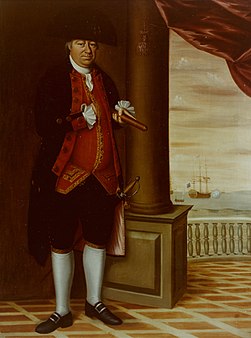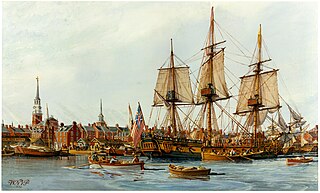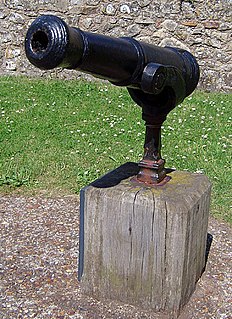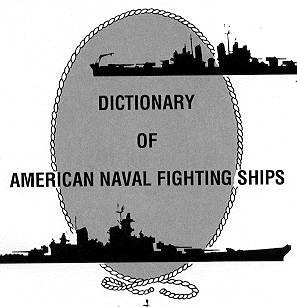
Abraham Whipple was an American Revolutionary War commander in the Continental Navy, and later one of the founders of Marietta, Ohio. Born near Providence, Colony of Rhode Island, Whipple chose to be a seafarer early in his life and embarked on a career in the lucrative West Indies trade, working for Moses and John Brown. In the French and Indian War period, he became a privateersman and commanded privateer Game Cock from 1759 to 1760. In one six-month cruise, he captured 23 French ships.

USS Providence was a sloop-of-war in the Continental Navy, originally chartered by the Rhode Island General Assembly as Katy. The ship took part in a number of campaigns during the first half of the American Revolutionary War before being destroyed by her own crew in 1779 to prevent her falling into the hands of the British after the failed Penobscot Expedition.

Alfred was the merchant vessel Black Prince, named for Edward, the Black Prince, and launched in 1774. The Continental Navy of what would become the United States acquired her in 1775, renamed her Alfred after 9th century English monarch Alfred the Great, and commissioned her as a warship. She participated in two major actions, the battle of Nassau, and the action of 6 April 1776. The Royal Navy captured her in 1778, took her into service as HMS Alfred, and sold her in 1782. She then became the merchantman Alfred, and sailed between London and Jamaica.
John Peck Rathbun (1746–1782) was an officer in the Continental Navy and in the United States Navy. Rathbun was from Rhode Island with family in Boston. Rathbun served in the Continental Navy from its late 1775 beginning as John Paul Jones First Lieutenant.
Daniel Waters was an officer in the Continental Navy and in the United States Navy.
The first USS Hancock was an armed schooner under the Continental Army during the American Revolutionary War. Congress returned her to her owner in 1777.
USS Queen of France was a frigate in the Continental Navy. She was named for Marie Antoinette.
HMS Trepassey, often spelled "Trepassy", was a 14-gun brig-sloop of the Royal Navy, formerly the American privateer Wildcat, launched and captured in 1779. The Royal Navy purchased her in 1779. USS Alliance captured Trepassey in 1781. She became the American merchant vessel Defence. In 1782 HMS Jason captured Defense, which the Royal Navy took back into service under her earlier name. The Navy sold her in 1784.
The second Providence, a 28-gun frigate, built by Silvester Bowes at Providence, Rhode Island, by order of the Continental Congress, was launched in May 1776.
USS Warren was one of the 13 frigates authorized by the Continental Congress on 13 December 1775. With half her main armament being 18-pounders, Warren was more heavily armed than a typical 32-gun frigate of the period. She was named for Joseph Warren on 6 June 1776. Warren was burned to prevent capture in the ill-fated Penobscot Expedition in 1779.
HMS Ariel was a 20-gun Sphinx-class sixth-rate post ship of the Royal Navy. The French captured her in 1779, and she served during the American Revolutionary War for them, and later for the Americans, before reverting to French control. as well as the British. Her French crew scuttled Ariel in 1793 to prevent the British from recapturing her.

HMS Lowestoffe was a 32-gun fifth-rate frigate of the Royal Navy. Built during the latter part of the Seven Years' War, she went on to see action in the American War of Independence and the French Revolutionary War, and served often in the Caribbean. A young Horatio Nelson served aboard her shortly after passing his lieutenant's examination.

HMS Camilla was a Royal Navy 20-gun Sphinx-class post ship. Camilla was built in Chatham Dockyard to a design by John Williams and was launched in 1776. She served in the American Revolution, the French Revolutionary Wars, and the Napoleonic Wars, before being sold in 1831.

Tyrannicide was a 14-gun brigantine-rigged sloop of the Massachusetts State Navy. The ship was built for the American Revolutionary War and participated in commerce raiding until destroyed in the Penobscot expedition.
HMS Surprise was a 28-gun Enterprise-class sixth-rate frigate of the Royal Navy, which served throughout the American Revolutionary War and was broken up in 1783.
HMS Diligent was a brig the Royal Navy purchased in 1777. The Continental Navy captured her in May 1779 and took her into service as the USS Diligent. She then participated in the disastrous Penobscot Expedition where her crew her crew had to scuttled her in August to prevent the British from capturing her.
George Wait Babcock was one of the most successful American privateers of the American Revolution, capturing 28 British vessels on the Marlborough. He also led the land forces in the Raid on Lunenburg (1782) during the American Revolution.













